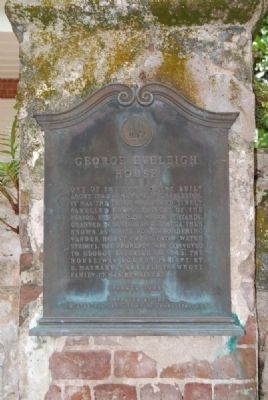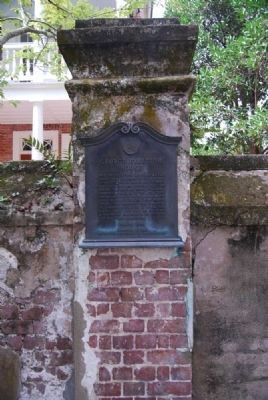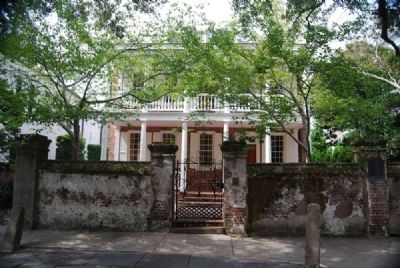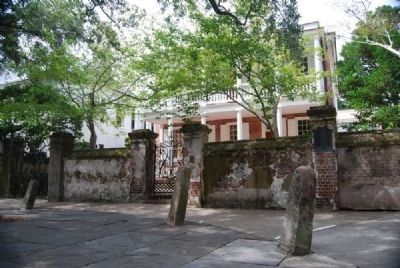South of Broad in Charleston in Charleston County, South Carolina — The American South (South Atlantic)
George Eveleigh House
Erected 1948 by Historical Commission of Charleston, S.C.
Topics. This historical marker is listed in this topic list: Notable Buildings. A significant historical year for this entry is 1743.
Location. 32° 46.367′ N, 79° 55.767′ W. Marker is in Charleston, South Carolina, in Charleston County. It is in South of Broad. Marker is on Church Street, on the left when traveling north. Touch for map. Marker is at or near this postal address: 39 Church Street, Charleston SC 29401, United States of America. Touch for directions.
Other nearby markers. At least 10 other markers are within walking distance of this marker. 42 Church Street (within shouting distance of this marker); Dr. Vincent Le Seigneur House (within shouting distance of this marker); Young-Johnson House (within shouting distance of this marker); Joseph Verree House (within shouting distance of this marker); Daniel Huger House (about 300 feet away, measured in a direct line); The Julius L. Lee House (about 300 feet away); 36 Meeting Street (about 300 feet away); William Bull's House (about 300 feet away); James Verree House (about 300 feet away); 6 Water Street - Francis Saltus House (about 400 feet away). Touch for a list and map of all markers in Charleston.
Additional commentary.
1. George Eveleigh House, 39 Church Street
Although this house is set back from the street and has an asymmetrically placed front door leading onto a front piazza, it originally had a center door leading to a larger of two front rooms. front and rear piazzas appear on the 1795 plat of the property, indicating a feature usually added after the Revolution. Nonetheless, an account of the hurricane of 1752 refers to the destruction of brick columns on the front of the building, and closer bricks in the central aperture of the second-floor brickwork confirm the presence of an earlier piazza. The Eveleigh House is of the same floor plan as the Thomas Rose House at 59 Church street, built eight years earlier, if slightly smaller in scale. As in the Rose House, much of the original paneling remains, with similar arched cupboards or bowfats in the second-floor drawing room. Most of the original mantels were removed long ago. In the early twentieth century, mantels from the demolished Nathaniel Heyward House on East Bay Street were installed in the principal room and the two rear rooms on the first floor were combined to create a dining room. Of particular interest on the exterior are the brickwork and window openings with segmental arched heads.
George Eveleigh was a prosperous deerskin trader in Charles Town when he purchased a lot lying across Vanderhorst Creek just outside the former city wall line. The creek was filled and is known today as Water Street, and with this filling Church street was extended to White Point. Eveleigh sold the property about ten years later to John Bull, a wealthy planter in Prince William Parish. The Bull family later subdivided the rear of the lot facing Meeting Street, where they subsequently constructed 34 Meeting Street. A later purchaser of 39 Church Street was the eighteenth-century chemist and naturalist Jean Louis Polony, a Santo Domingan refugee. (Source: The Buildings of Charleston: A Guide to the City's Architecture by Jonathan H. Poston (1997) pgs 216-217.)
— Submitted September 26, 2011, by Brian Scott of Anderson, South Carolina.
Credits. This page was last revised on February 16, 2023. It was originally submitted on September 26, 2011, by Brian Scott of Anderson, South Carolina. This page has been viewed 1,226 times since then and 38 times this year. Photos: 1, 2, 3, 4. submitted on September 26, 2011, by Brian Scott of Anderson, South Carolina.



